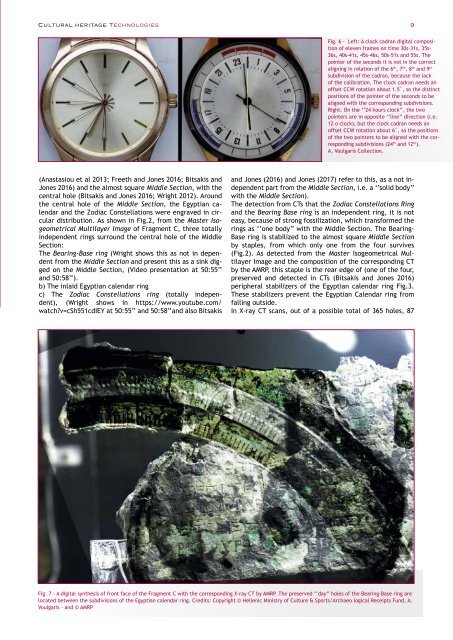Archeomatica International 2017
Special supplement to Archeomatica 3 2017
Special supplement to Archeomatica 3 2017
You also want an ePaper? Increase the reach of your titles
YUMPU automatically turns print PDFs into web optimized ePapers that Google loves.
Cultural heritage Technologies 9<br />
Fig. 6 - Left: A clock cadran digital composition<br />
of eleven frames on time 30s-31s, 35s-<br />
36s, 40s-41s, 45s-46s, 50s-51s and 55s. The<br />
pointer of the seconds it is not in the correct<br />
aligning in relation of the 6 th , 7 th , 8 th and 9 th<br />
subdivision of the cadran, because the lack<br />
of the calibration. The clock cadran needs an<br />
offset CCW rotation about 1.5˚, so the distinct<br />
positions of the pointer of the seconds to be<br />
aligned with the corresponding subdivisions.<br />
Right: On the ‘’24 hours clock’’, the two<br />
pointers are in opposite ‘’line’’ direction (i.e.<br />
12 o clock), but the clock cadran needs an<br />
offset CCW rotation about 6˚, so the positions<br />
of the two pointers to be aligned with the corresponding<br />
subdivisions (24 th and 12 th ).<br />
A. Voulgaris Collection.<br />
(Anastasiou et al 2013; Freeth and Jones 2016; Bitsakis and<br />
Jones 2016) and the almost square Middle Section, with the<br />
central hole (Bitsakis and Jones 2016; Wright 2012). Around<br />
the central hole of the Middle Section, the Egyptian calendar<br />
and the Zodiac Constellations were engraved in circular<br />
distribution. As shown in Fig.2, from the Master Isogeometrical<br />
Multilayer Image of Fragment C, three totally<br />
independent rings surround the central hole of the Middle<br />
Section:<br />
The Bearing-Base ring (Wright shows this as not in dependent<br />
from the Middle Section and present this as a sink digged<br />
on the Middle Section, (Video presentation at 50:55’’<br />
and 50:58’’).<br />
b) The inlaid Egyptian calendar ring<br />
c) The Zodiac Constellations ring (totally independent),<br />
(Wright shows in https://www.youtube.com/<br />
watch?v=cSh551cdIEY at 50:55’’ and 50:58’’and also Bitsakis<br />
and Jones (2016) and Jones (<strong>2017</strong>) refer to this, as a not independent<br />
part from the Middle Section, i.e. a ‘’solid body’’<br />
with the Middle Section).<br />
The detection from CTs that the Zodiac Constellations Ring<br />
and the Bearing Base ring is an independent ring, it is not<br />
easy, because of strong fossilization, which transformed the<br />
rings as ‘’one body’’ with the Middle Section. The Bearing-<br />
Base ring is stabilized to the almost square Middle Section<br />
by staples, from which only one from the four survives<br />
(Fig.2). As detected from the Master Isogeometrical Multilayer<br />
Image and the composition of the corresponding CT<br />
by the AMRP, this staple is the rear edge of (one of the four,<br />
preserved and detected in CTs (Bitsakis and Jones 2016)<br />
peripheral stabilizers of the Egyptian calendar ring Fig.3.<br />
These stabilizers prevent the Egyptian Calendar ring from<br />
falling outside.<br />
In X-ray CT scans, out of a possible total of 365 holes, 87<br />
Fig. 7 - A digital synthesis of front face of the Fragment C with the corresponding X-ray CT by AMRP. The preserved ‘’day’’ holes of the Bearing-Base ring are<br />
located between the subdivisions of the Egyptian calendar ring. Credits: Copyright © Hellenic Ministry of Culture & Sports/Archaeo logical Receipts Fund, A.<br />
Voulgaris - and © AMRP


















